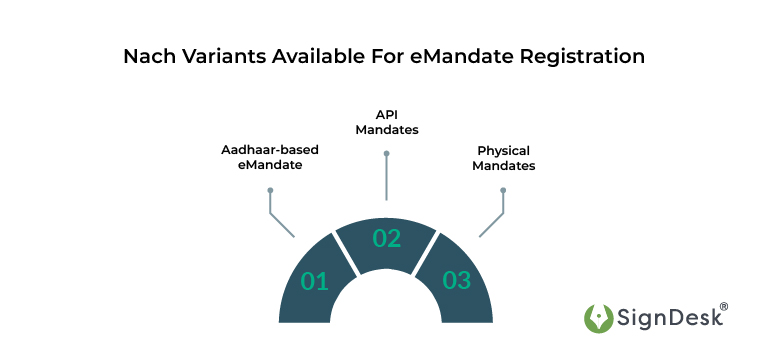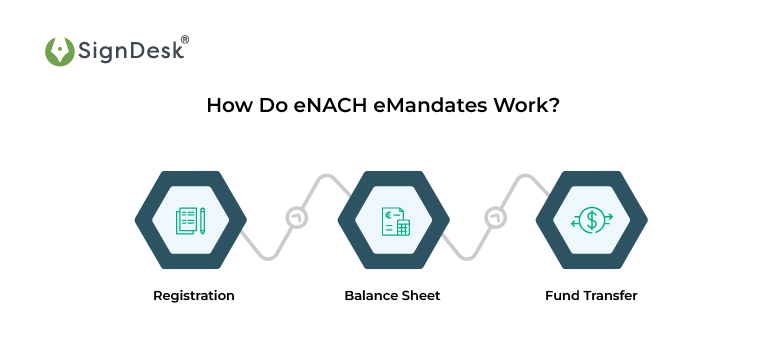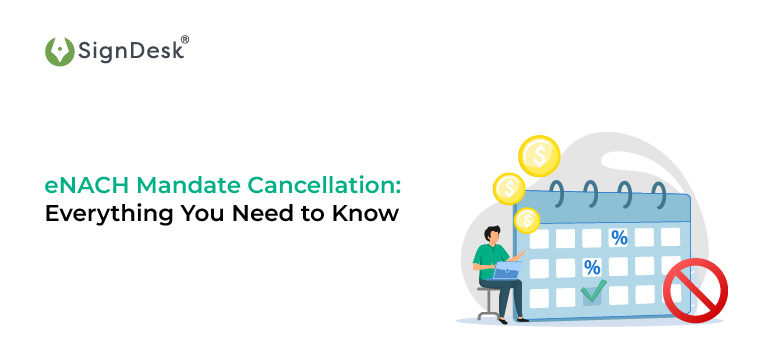Mandates and eNACH Cancellation: An Overview
The National Automatic Clearing House (NACH) is an interbank payment mechanism that is utilised for large, frequent, or high-volume transfers and also helps in eNACH cancellation. NACH operates by establishing a mandate that authorises an institution to debit or credit funds from an individual’s account which is called mandates.
A mandate is a standing instruction (SI) provided to a bank or NBFC to debit a specified sum from the client approving the mandate’s account on a regular basis.
eMandates are excellent tools for enabling both regular and one-time payments, and they are used for a number of purposes. Recurring payments for OTT subscriptions, utility bills, loan EMIs, insurance premiums, mutual fund investments, and gaming platform subscriptions all include some type of e-mandate.
The eNACH eMandate mechanism was designed to automate regular payments while eliminating the need for documentation. The necessity to fill out NACH forms and transport NACH documentation from bank to bank is eliminated with eNACH eMandates.
When adopting electronic NACH, the mandatory registration procedure may be finished in a matter of hours because the entire system requires minimal human involvement and has a low logistical reliance. eNACH cancellation can also be completed online by simply logging into the Nach mandate platform and selecting which mandates to cancel.
Users can register a variety of Nach variants using eNach eMandate solutions.
Nach Variants Available For eMandate Registration
Nach variants are distinguished based on the mode of registration. The various forms of mandates that can be utilized for eNACH cancellation, as well as registration, are listed below:
- Aadhaar-based eMandate
Mandates are registered after Aadhaar OTP authentication. The usre enters their emandate registration information in the portal and agrees to the linkage of Aadhaar records. The user’s Aadhaar-registered cellphone number is subsequently issued an OTP, which is used to authenticate.
- API Mandates
In this form of eMandates, the eMandate provider automatically collects API Mandate Data and directs the user to the NPCI ONMAGS site. The mandate data is then submitted to the client’s destination bank (where the client has an account) for confirmation, and once received, the client is directed to the destination bank to validate the mandate by entering their debit card or NetBanking details.
- Physical Mandates
Clients fill their mandate details in a form affixed with a QR code. This form is then electronically scanned and the registration details are sent to the customer’s destination bank. The mandate is registered once the information is verified by the destination bank and NPCI.

How Do eNACH eMandates Work?
The NACH eMandate workflow is divided into three stages:
- Registration: Mandates are prepared and registered in the manner described above.
- Balance sheet presentation: A document including all of the debit information is sent to NPCI and the destination banks will fulfil the payment subject to the availability of funds.
- Fund transfer: As part of the clearing procedure, NPCI will finalise the settlements between the sponsor and the destination bank. The money is subsequently transferred to the creditor from the destination bank.

NPCI Guidelines For Mandate Cancellation
One of the important services to be provided to customers is the capability to terminate or cancel a mandate issued to corporations, NBFCs, banks, or any other business. Earlier, the consumer had to contact either the corporate office or a bank branch and submit the eNACH cancellation request in writing.
As per NPCI, to simplify the online submission of client requests for mandate cancellation, all organisations acquiring the mandate from the customer must give the consumer the option of submitting the eNACH cancellation request through their website or any other electronic channels.
In the event of a stop instruction, the customer should be able to withdraw the instruction so that the present mandate may be continued.
There are certain pre-requisite conditions laid out by NPCI for the whole eNACH cancellation.
- All corporations, banks, and other institutions filing mandates online must include a link to mandate cancellation, suspension, or revocation on their website or portal.
- Issuer banks must be certified to enable the capability via all three authentication modalities.
- Sponsor banks must make the required arrangements to receive data on cancelled, suspended, or revoked mandates and transmit it on to the respective corporates.
How to Cancel eMandates on NACH Platforms
The guidelines for submitting an electronic mandate cancellation request on various NACH platforms can be understood from the following steps:
- The customer should be authenticated using a login ID and password, an OTP, or any other method established by an internal process.
- The ability to display a list of registered mandates for a customer ID (physical mandates and E-Mandates).
- The consumer should have the option of selecting which requirements to cancel, and cancellation requests should be allowed only after customer verification.
- A pop-up message should be displayed informing the customer that they are about to terminate a lawful requirement and asking for reconfirmation. If the consumer agrees to the cancellation, the corporation should go forward with it.
- SMS should be delivered to the customer’s registered mobile phone telling him/her that he/she has begun the process of cancelling a mandated registration for his/her account.
- After approving the customer’s mandate cancellation request, the business must draft and submit the cancellation file through its sponsor bank on the same day.
- After receiving the final response from NACH via its sponsor bank, entities should amend the cancellation request.
- After obtaining confirmation of mandate cancellation, an SMS confirming mandate cancellation shall be issued to the consumer.
- Entities should update their records and not exhibit transactions for requirements that the client has cancelled.
On the completion of the whole process, the customer would receive a message including the following text: “Your mandate with number UMR number>> registered for Entity name>> in your account ending last 4 digit account number>> for the purpose of mandate>> has been cancelled with effect from the cancellation date>>.”
This indicates that the mandate cancellation process has been a success.
What are the Benefits of NACH Mandates?
E-mandates are among the most convenient solutions for automating recurring payments, with capabilities such as real-time mandate tracking, user roles and access, and Aadhaar eSign mandate interfaces.
eNACH mandates provide various benefits to both clients and businesses:
- Easy Payments:
eNACH e-mandates provide hassle-free and readily controllable payments, which streamlines company procedures. Mandates are recorded and tracked on a smart dashboard, and they may be amended and deleted as needed. They are also handled online.
- Strong Audit Trail:
With the e-mandate method, clients can keep track of every transaction. Previous transactions may all be tracked and analysed, and transaction history is kept to increase audit efficiency.
- User Friendly Interface:
eNACH e-mandates are designed to allow clients to develop and register mandates with minimal effort. Customers may make mandates directly from any OTT platform, merchant, or subscription provider’s website. Mandates are shown on a user-friendly dashboard, where the progress of all mandates may be followed for business purposes. Customers may also easily amend or delete mandates on the eNACH e-mandate platform.
- Cost-effective Payment Automation:
Not automating regular payments costs organisations more than automating them. This is due to the fact that payment automation significantly decreases operating expenditures as well as the total time required to handle and collect payments. Furthermore, regular payment automation eliminates human dependency, freeing up resources for more effective use.
- Convenient Payment Workflows:
eMandate automated workflows are extremely easy for businesses to integrate and customers to use. The majority of the e-mandate procedure is handled by the e-mandate service provider, and end users only need to register mandates, sit back, and wait for payments.
Automate Recurring Payments in Minutes with SignDesk
Customers may securely authenticate e-mandates online using SignDesk’s mandate solutions – Link.It, utilising a debit card, NetBanking, or Aadhaar eSign. It. Mandates are further protected using Additional Factor Authentication if a debit is planned (AFA).
Mandates may be generated, registered, modified, monitored, and withdrawn using the smart dashboard. Transaction histories and obligatory failure rates are provided, allowing organisations to build a trustworthy audit trail for payments.
Unlike physical requirements, electronic mandates allow businesses to digitally scale up their payments, automate effectively, and significantly cut operational expenditures. Schedule a free demo now to reap the benefits of SignDesk’s premier e-mandate solution and speed payments as well as eNACH cancellation process.
